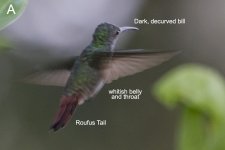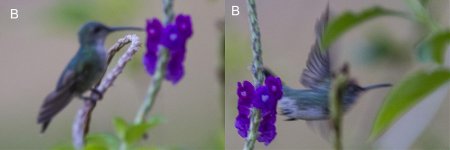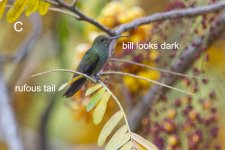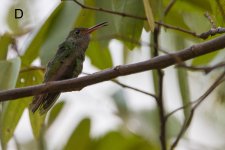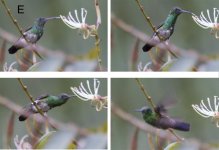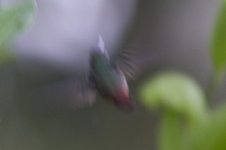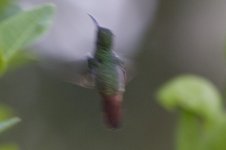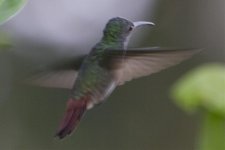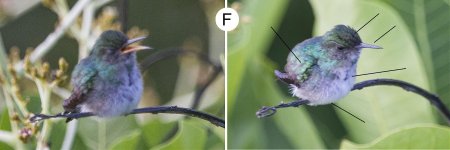Victor Soares
Well-known member
I have just returned from a most fantastic trip to Panama where I got to see hummingbirds for the first time in my life. I was using a very well illustrated book: THE BIRDS OF PANAMA by Angehr and Dean but needless to say I am still very much lost with all the little details of the different hummers (and there are so many different hummers too). Therfore please could you assist with the attached. My comments are as follows:
A
Confused as to whether this could be a VERAGUAN MANGO or a RUFOUS-TAILED HUMMINGBIRD:
Veraguan Mango
YES - Location: Boca Chica, Chiriqui
YES – Photo shows bill dark and decurved (as in book)
YES – Photo is possibly of a Female or Immature showing mostly white belly and throat (as in book)
NO – Photo does not show white tips on tail (as shown in female Veraguan in book)
Rufous-tailed Hummingbird
YES - Location: Boca Chica, Chiriqui
NO - Bill is dark and decurved (book shows reddish bill)
NO - Book does not show white belly or throat
B - sorry, I know this photo is completely out of focus, but I am still hoping to get an ID
Think this may be the same bird as in A and again shows a white belly and throat and a longish decurved black bill
C
Think this is a male RUFOUS-TAILED HUMMINGBIRD but book shows the bill as reddish whereas the photo shows a blackish bill
D
This may also be a RUFOUS-TAILED HUMMINGBIRD but the deep red lower bill contrasting with the dark upper bill is confusing – could this be a young bird?
E
Think this is a SNOWY-BELLIED HUMMINGBIRD due to the obvious white belly although the lack of rufous colour on the tail (photo 4) is confusing – this may also be a young bird
A
Confused as to whether this could be a VERAGUAN MANGO or a RUFOUS-TAILED HUMMINGBIRD:
Veraguan Mango
YES - Location: Boca Chica, Chiriqui
YES – Photo shows bill dark and decurved (as in book)
YES – Photo is possibly of a Female or Immature showing mostly white belly and throat (as in book)
NO – Photo does not show white tips on tail (as shown in female Veraguan in book)
Rufous-tailed Hummingbird
YES - Location: Boca Chica, Chiriqui
NO - Bill is dark and decurved (book shows reddish bill)
NO - Book does not show white belly or throat
B - sorry, I know this photo is completely out of focus, but I am still hoping to get an ID
Think this may be the same bird as in A and again shows a white belly and throat and a longish decurved black bill
C
Think this is a male RUFOUS-TAILED HUMMINGBIRD but book shows the bill as reddish whereas the photo shows a blackish bill
D
This may also be a RUFOUS-TAILED HUMMINGBIRD but the deep red lower bill contrasting with the dark upper bill is confusing – could this be a young bird?
E
Think this is a SNOWY-BELLIED HUMMINGBIRD due to the obvious white belly although the lack of rufous colour on the tail (photo 4) is confusing – this may also be a young bird




